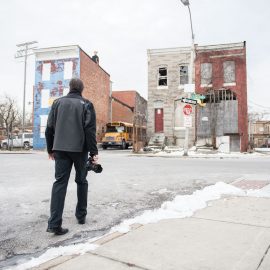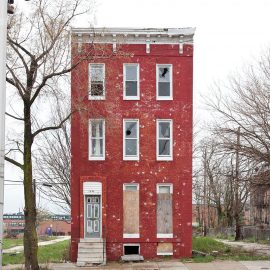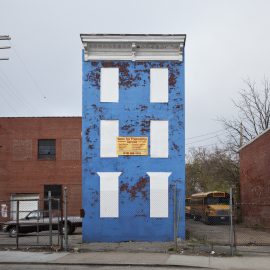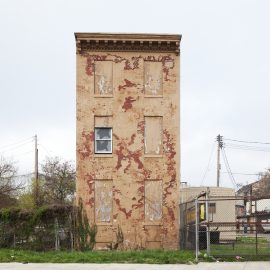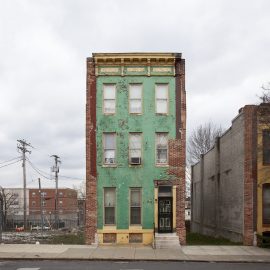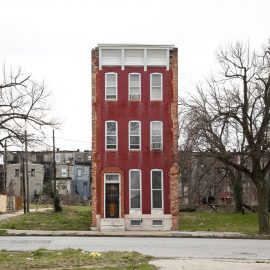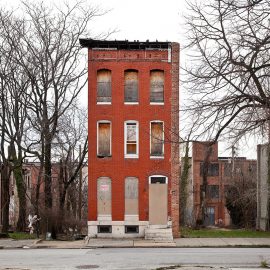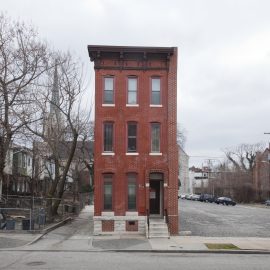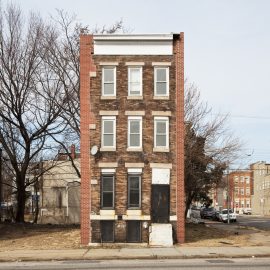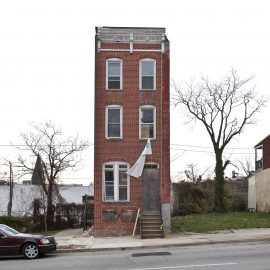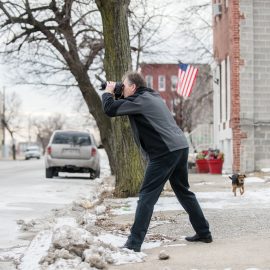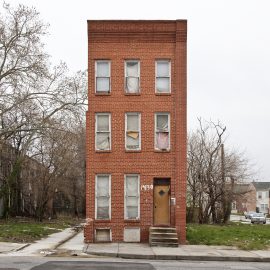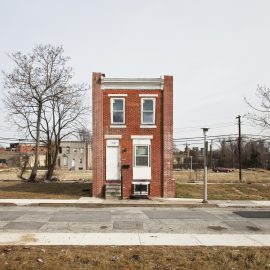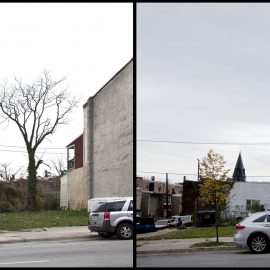Arts & Culture
Remnants of Things Past
A local photographer’s portraits of isolated row houses are garnering international attention.
A decade and a half ago, photographer Ben Marcin hiked—not
hitchhiked—from Baltimore to Philadelphia, traversing as many remote
farms and wooded areas as possible along the way. He estimates he’s
completed more than 5,600 hikes, two each weekend, one mid-week, give or
take, for the past 40 years, mostly in the counties surrounding
Baltimore. But his meanderings also include far-flung places like
Guatemala’s Mayan highlands, rural Mexico, India, and Montenegro. His
first pilgrimage, at four years old, began at the kitchen door of his
family’s house in the small German town where he was born. “I crossed
over the railroad tracks, cut through a cornfield, went through some
woods, and walked into town where I asked a traffic cop at an
intersection to get my Dad,” he recalls with a laugh. “I was out of gas
and wasn’t sure how to get home.”
Since earning an economics
degree from the University of Maryland, Baltimore County, he’s held down
a job at the Social Security Administration for the past three decades,
but he’s always had this other side, the solo expeditioner part, that
is also linked to an artistic impulse.
He tried watercolor
painting initially—“Looks easy but it’s not,” he says—and didn’t buy his
first camera until he was 27. Like many people, the first photos he
took tended to be travel pictures from exotic destinations. Later,
self-taught, he began playing with color and infrared images and
eventually had three shows at Hampden’s Gomez Gallery, which closed in
2003.
He’s now 55, and although his hair has grayed, he remains as
fit, restless, and curious as ever. Over the years, however, his
photography has turned closer to home, more inward, “to stories,” as he
puts it. Begun in 2010, his series,
Last House Standing—large-scale
portraits of literally the last row house standing on different city
blocks, often no more than two miles from his own Bolton Hill row
home—is garnering the first international attention of his career, with
reviews from the United Kingdom, Italy, Germany, and China, not to
mention cultural observers like
The Paris Review, Slate, and Wired.
The stark, unsentimental photos manage to reveal both the decay and
ghostly beauty of some of Baltimore’s iconic row houses and their fading
environs.
“Monuments,” Marcin calls the withered, three-story, last turn-of-the-century row houses, “to dead neighborhoods.”
“The
irony isn’t lost on me,” he adds. “All the traveling I’ve done, and, in
the end, what I find most compelling has been right here all along.”
In many ways, Marcin’s Last House Standing
photographs are more remarkable for what they leave out than for what
they show. There are no cars out in front of the homes in the barren
streets and, except for the odd air-conditioning unit or bed sheet in an
upstairs window, few signs of life, if any, can be seen in the
pictures. Some of the homes clearly appear to be vacant, boarded up at
least, but not all.
There are no leaves on the trees nearby, no
clouds or sunshine in the backdrop, just overcast, dull skies in nearly
every photograph. There is rarely even a street sign or lamppost in the
frame, and there are no people. But the most obvious things missing are
the neighboring homes—leaving the jarring juxtaposition of a house that
is 15 feet wide and 40 feet tall standing by itself in an empty lot. “No
engineer or architect would design a structure like that,” says Marcin,
who moved to the U.S. when he was 10. “They were meant to be attached
to something else.”
Inevitably, viewers begin to consider the ages
of these homes and the lives of those who once inhabited these odd,
solitary structures, suddenly alone in the middle of once-thriving
residential blocks. “A hundred people, generations of families, likely
lived in these houses over the course of their lives, especially as they
were divided into apartments,” says Marcin, staring at a towering
Mosher Street row house with an outline of brick remnants from its
former next-door neighbor still affixed to an exterior wall. Outside
another, similar but still-inhabited home, a different question arises
for Marcin during a recent shooting trip: “What is it about the person
who still lives here, the last person on their block, that made them
defiant enough to stay when everyone else left?”
Austere and self-possessed, the pictures are also sobering images of urban disintegration.
“Certainly,
the photographs are social and political statements, particularly for
what has and is happening in Baltimore,” says Constantine Grimaldis, who
in 1977 opened the prominent North Charles Street gallery which bears
his name and hosted a
Last House Standing exhibition earlier
this year. “They are also very good photographs, very good art, and the
composition goes to that. He’s interested in all of that [the fine art
aspects], but he’s also intensely interested in life, and that comes
through in his work.”
Grimaldis adds that photos like Marcin’s may
look deceptively simple at a glance, “but like all art,” he says, “it
doesn’t just happen in front of you.
“It takes time to do the work
and, at the same time, derive the meaning from it during the process,”
Grimaldis says. “In Ben’s case, it also took time to find these places.”
Marcin,
not surprisingly, stumbled across his first “last house standing” in
2010, during a lunchtime bike trek from Social Security Administration
headquarters in Woodlawn back into the city. As always, compelled to
explore the unfamiliar, he found himself in some of the struggling
neighborhoods of West Baltimore. (While acknowledging the need to take
safety precautions during his shooting trips, he jokes that he’s more
afraid that his wife, Lynn, whom he met when she was the curator at the
Gomez Gallery, will at some point organize an intervention and put a
stop to his wanderings. He’s never had any problems during his current
project, but over the years has had warning shots fired over his head by
farmers and was once robbed in Mexico by a police officer.)
“You can ride through Sandtown-Winchester, Poppleton, Harlem Park, for miles, and so much of it is desolate,” he says, noting the city’s estimated 16,000 vacant houses and plans to demolish dozens of “last houses standing” via eminent domain over the next few years. “Boarded-up block after boarded-up block—and you see very few people.
“The first house that stopped me in my tracks,” he continues, “was three stories, painted light blue, boarded windows painted white for some reason. It looked like a face staring at me with six eyes.” Marcin says he knew the house would make a great photo by itself, but then came across another three-story row house standing alone farther down the same street. That was the beginning.
First and foremost, Marcin’s concentration has been centered on “taking good pictures.” He settled on creating a typology—a series—that highlighted the unique architecture and haunting grace of the brick buildings. “These homes were meant to last hundreds of years,” he says. “They have these ornate cornices, but now also years of wear and tear and peeling paint. It’s as if their skin is old and wrinkled, but if you look, you can still see the youthful beauty that was there at one time.”
And although he views his work through a personal, storytelling lens—“I’m not a political activist, I don’t go to meetings”—he’s fully aware that his photographs also evoke themes of urban poverty, decay, and dislocation. The context, distance, and objectivity of the pictures create space for interpretation on different levels, opening discussions about population loss and blight, inevitable among the first reactions for Baltimoreans who recognize their city in the pictures.
“We live in times where we all see what’s happening all over the world, traveling through the Internet, experiencing everything that’s uploaded on YouTube,” says Doreen Bolger, director of The Baltimore Museum of Art, who describes herself as a fan of Marcin’s work, including a previous series on homeless encampments. “At the same time we have this global perspective, there is something very powerful about the local. It’s so important to understand the richness and the history of the different places in the city in which we live.”
As his Last House Standing project continues, it’s evolving. Some of the first houses Marcin photographed have subsequently been knocked down, and he’s returning to those blocks, documenting the erasure of the last row house on the street, preparing to create before-and-after diptychs.
“What I’ve been interested in all along is not ‘ruin porn,’” Marcin says, referring to a term sometimes used to describe overtly exploitative photography from Rust Belt locales such as Detroit, MI, or Braddock, PA, outside Pittsburgh, “but capturing the memories and transition these houses represent. In that sense, taking a picture of what it looks like after it’s gone is a pretty obvious thing to do next.”
